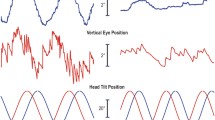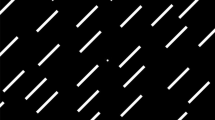Abstract
By means of real-time infra-red video-oculography we studied eye torsion in 12 normal healthy subjects. Ocular torsion was induced by visual stimulation or static whole body roll with and without visual orientation (“head-fixed” or “earth-fixed”). Visual stimulation was achieved by a horizontal grating that oscillated sinusoidally in a frontal plane. The oscillation frequency varied from 0 to 0.6 Hz while amplitude varied from 6° to 33°. Visual orientation during whole body roll was established by mounting a 32 lx illuminated horizontal grating either on a tilting device (head-fixed) or on the wall in the frontal plane (earth-fixed). Maximum visual-induced eye torsion gain was reached at about 0.2 Hz. No eye torsion was observed in static (0 Hz) visual tilts of the grating. Maximum gain was about 0.36 at amplitudes between 6° and 10°. Eye torsion gain decreased with increasing amplitude and increasing frequency (> 0.2 Hz). Static whole body roll in the dark up to 180° clockwise and counter-clockwise induced static ocular counter rolling with a maximum amplitude of 12° and a maximum gain of 0.22. Gain decreased with increasing roll down to zero at 180°. Visual orientation with either head or earth fixed did not affect the amplitude or gain of the body roll induced ocular counter-rolling. The results are interpreted in terms of improving the reliability of clinical statolith testing and understanding the processes involved in motion sickness.
Similar content being viewed by others
References
Cheung BS, Money K, Howard I, Kirienko N, Johnson W, Lackner J, Dizio P, Evanof J (1992) Human ocular torsion during parabolic flights: an analysis with scleral coil. Exp Brain Res 90: 180–188
Clark AH, Teiwes W, Scherer H (1991) Videooculography — an alternative method for measurement of three dimensional eye movements. In: Schmidt R, Zambieri D (eds) Oculomotor control and cognitive processes. Elsevier, Amsterdam, pp 431–443
Curthoys IS, Dai MJ, Halmagyi GM (1991) Human torsional ocular position before and after unilateral vestibular neurectomy. Exp Brain Res 85: 218–225
Kingma H, Gulikers H, Jong I de, Jongen R, Dolmans M, Stegeman P (1995) Real time binocular detection of horizontal vertical and torsional eye movements by an infrared video-eye tracker. Acta Otolaryngol (Stockh) [Suppl] 520: 9–15
Van Rijn LJ, Van der Steen J, Collewijn H (1994) Eye torsion elicited by oscillating gratings: effects of orientation, wavelength and stationary contours. Vision Res 34: 533–540
Author information
Authors and Affiliations
Rights and permissions
About this article
Cite this article
Kingma, H., Stegeman, P. & Vogels, R. Ocular torsion induced by static and dynamic visual stimulation and static whole body roll. Eur Arch Otorhinolaryngol 254 (Suppl 1), S61–S63 (1997). https://doi.org/10.1007/BF02439726
Issue Date:
DOI: https://doi.org/10.1007/BF02439726




